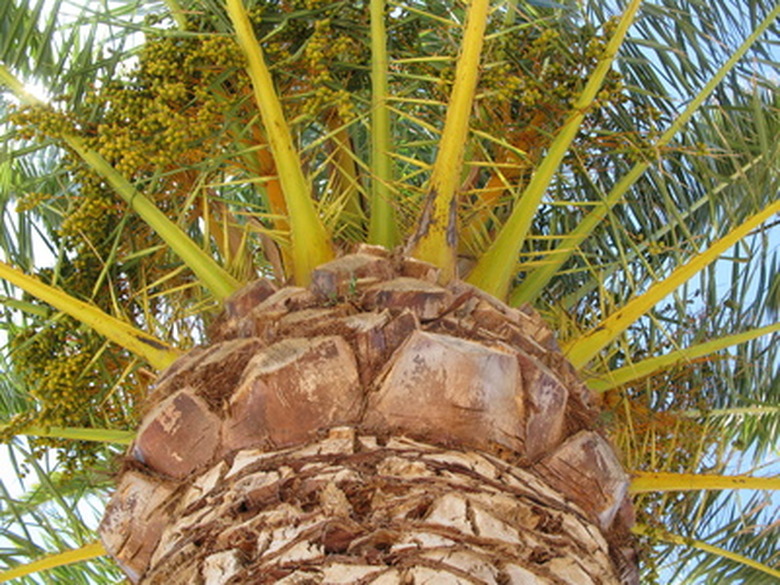Canary Island Date Palm Diseases
A magnificent single-trunk palm, Canary Island date palm (Phoenix canariensis) prospers in warm climates and when exposed to more than 10 hours of direct sunlight daily. Wet and cold soils lead to this palm's demise, as can a few diseases, especially if the palm is already damaged or stressed by inhospitable growing conditions. Grow this palm in USDA Plant Hardiness zones 8 and warmer.
Ganoderma
Stressed and damaged Canary Island date palms often become inflicted with the ganoderma fungus (Ganoderma applanatum). A mushroom-like conk develops at the base of the trunk, the result of the vascular tissues being infested with the proliferating fungus. A wet trunk and wet soil encourage this disease. Palms that sustained tears, lacerations or trunk punctures during the planting or transportation bear increased risk for ganoderma.
- A magnificent single-trunk palm, Canary Island date palm (Phoenix canariensis) prospers in warm climates and when exposed to more than 10 hours of direct sunlight daily.
- Wet and cold soils lead to this palm's demise, as can a few diseases, especially if the palm is already damaged or stressed by inhospitable growing conditions.
Fusarium Wilt
Once contracted, no treatment exists for a palm infested with the fusarium fungus (Fusarium oxysporum f. sp. canariensis)–even fungicide applications prove futile. Fusarium spreads among palms readily by dirty pruning blades and other landscaping equipment. Once infested, one-half of the frond's leaflets dry and brown and often a dark reddish brown streak develops on the petiole or frond stem.
James Downer of the University of California at Davis comments that many people quickly regard the browning of fronds on the palm as the result of fusarium wilt, but may actually be caused by other fungi such as pink rot pathogen (Gliocladium vermoeseni), Diplodia phoenicum and Dothiorella spp. Or, these fungi that dwell in the Canary Island date palm's vascular system interact with each other to lead to stalk and leaf rot or other rotting symptoms.
Leaf Spot
Often called false smut, leaf spot occurs on the lowest fronds of Canary Island date palms, resulting from the fungus Graphiola phoenicis. It is a cosmetic disease, and won't lead to the decline or harm of the plant. Harm results when overly ambitious landscapers or gardeners dislike seeing the tiny cup-shaped black spots on the frond leaflets and cut them away, robbing the palm of food-making tissues.
- Once contracted, no treatment exists for a palm infested with the fusarium fungus (Fusarium oxysporum f. sp.
- James Downer of the University of California at Davis comments that many people quickly regard the browning of fronds on the palm as the result of fusarium wilt, but may actually be caused by other fungi such as pink rot pathogen (Gliocladium vermoeseni), Diplodia phoenicum and Dothiorella spp.
Lethal Yellowing
Canary Island date palms rarely succumb to lethal yellowing, having a slight susceptibility to the bacterium that attacks the plant's phloem vascular tissues. The bacterium spreads by a planthopper (Myndus crudus). The insect moves the phytoplasma from palm to palm as it moves during its feeding cycles. In the date palm, lethal yellowing manifests by yellowing and browning of fronds, eventually causing newly emerging fronds to collapse and the growing tip, the crownshaft, to die. Infected palms die within three to five months after symptoms appear. Management of lethal yellowing disease usually involves the injection of the antibiotic oxytetracycline HCl (commonly called OTC). It does not kill the bacterium, but reduces the infection to levels that do not cause frond decline and the palm survives.
- Canary Island date palms rarely succumb to lethal yellowing, having a slight susceptibility to the bacterium that attacks the plant's phloem vascular tissues.
- In the date palm, lethal yellowing manifests by yellowing and browning of fronds, eventually causing newly emerging fronds to collapse and the growing tip, the crownshaft, to die.
Texas Phoenix Decline
Also caused by a phytoplasma that is genetically distinct from the lethal yellowing phytoplasma is Texas Phoenix decline. The symptoms and management of this disease on Canary Island date palms appear similar to that of lethal yellowing.
